
The Forest Home Farms is a 16-acre (6.5-hectare) municipal historic park located in San Ramon, California. In 1997, Ruth Quayle Boone bequeathed the land and all buildings on it to the City of San Ramon for use as a park and historical site in memory of her husband, Travis Moore Boone. After Ruth Boone's death in 1998 at the age of 94, the City expanded the memorial to include Ruth, in honor of her generosity to the people of San Ramon and in recognition of the contribution women made to agriculture in the San Ramon Valley.

Oxon Cove Park and Oxon Cove Farm is a national historic district that includes a living farm museum operated by the National Park Service, and located at Oxon Hill, Prince George's County, Maryland. It is part of National Capital Parks-East. It was listed on the National Register of Historic Places in 2003.
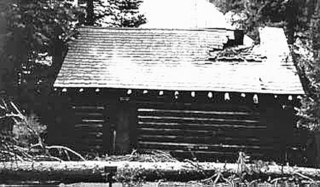
The Death Canyon Barn is a combination barn and ranger patrol cabin in Grand Teton National Park. The barn was built in Death Canyon on the Death Canyon Trail at its junction with the Alaska Basin Trail by the Civilian Conservation Corps in 1935 in the National Park Service rustic style. Located with a clear view of Prospector Mountain, it shares a common style and purpose with the Cascade Canyon Barn to the north in the park, with minor differences attributable to available materials and the preferences of the work crews building the barns.

The Hunter Hereford Ranch was first homesteaded in 1909 by James Williams in the eastern portion of Jackson Hole, in what would become Grand Teton National Park. By the 1940s it was developed as a hobby ranch by William and Eileen Hunter and their foreman John Anderson. With its rustic log buildings it was used as the shooting location for the movie The Wild Country, while one structure with a stone fireplace was used in the 1963 movie Spencer's Mountain. The ranch is located on the extreme eastern edge of Jackson Hole under Shadow Mountain. It is unusual in having some areas of sagebrush-free pasture.
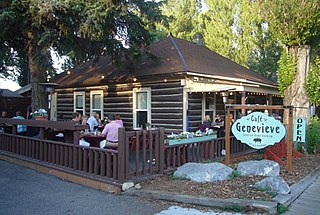
The Van Vleck House was built in Jackson, Wyoming in 1910–1011. The log house and barn are the only remaining residential structures in the vicinity of the Town Square.

Edgemoor Farm Dairy Farm was built as part of a dairy farm in 1913 in Santee, California. Edgemoor was part of a Spanish land grant to Maria Antonio Estudillo who married Miguel de Pedrorena, a native of Madrid. By the 1850s, through a variety of ways, individuals obtained portions of the grant and began to farm. Walter Hamlin Dupee purchased Edgemoor Farm in 1913 and built it into a national award-winning dairy farm, polo pony ranch and early tourist attraction.

The Rolfe Barn is a historic barn at 16 Penacook Street in the Penacook village of Concord, New Hampshire. The property was listed on the National Register of Historic Places in 2007. The barn was first added to the New Hampshire State Register of Historic Places in 2003; additional structures on the property were added in 2005 (homestead) and 2008.

Appleton Farm is a historic farmstead at 76 Brush Brook Road in Dublin, New Hampshire. It has housed Del Rossi's Trattoria for many years. It was built in the 1780s by the son of one of Dublin's early settlers, and remained in the family until 1950. The house and adjacent barn were listed on the National Register of Historic Places in 1983.

The Persia Beal House is a historic house at 797 Chesham Road in Harrisville, New Hampshire. It is now the Harrisville Inn. Built about 1842, it is one of the best-preserved 19th century connected farmsteads in the town. The property is also notable for its association with Arthur E. Childs, who purchased the property to serve as the estate farm for his nearby Aldworth Manor summer estate. The house was listed on the National Register of Historic Places in 1988.
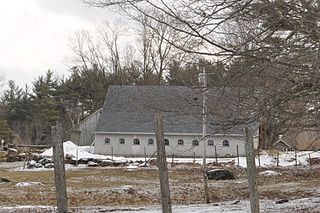
The Frost Farm is a historic farmstead on Korpi Road in Dublin, New Hampshire. It includes a farmhouse built in 1806 and subsequently enlarged, and a renovated 19th-century barn. The property is significant for its architecture, and for its ownership by both early settlers and later Finnish immigrants. A portion of the property was listed on the National Register of Historic Places in 1983.

The Stone-Darracott House is a historic house on Old Marlborough Road in Dublin, New Hampshire. It was built in 1792 by John Stone, an early settler of Dublin for whom nearby Stone Pond is named. The house was also made part of a "gentleman's farm" by Mrs. Alberta Houghton in the early 20th century, along with the adjacent Stone Farm. The house was listed on the National Register of Historic Places in 1983.

The Reuben Lamprey Homestead is a historic house at 416 Winnacunnet Road in Hampton, New Hampshire. Built in the 1770s, the property is the best-preserved colonial-era farm complex in the town. It was listed on the National Register of Historic Places in 1982.

The Gehlen House and Barn are historic buildings located in St. Donatus, Iowa, United States. Both buildings were built by Peter Gehlen, an immigrant from Luxembourg who settled in this area in 1846. He built a flour mill on the Tetes des Mortes Creek in 1848. As other immigrants from Luxembourg settled here they built distinctive houses from the local limestone. Of these the Gehlen house was the most significant. It is located at a crossroads, and because of its size it served as a community center. At one time or another it served as the post office, hotel, and general store. The exterior of the stone house is covered with plaster and features many windows and doorways on the long side, narrow eaves, a low-pitched jerkinhead, and a rear wing. The barn, which sits immediately behind the house is significant as one of the few stone barns in Iowa. The house and barn were listed on the National Register of Historic Places in 1979, and were included as contributing properties in the Village of St. Donatus Historic District in 1989.
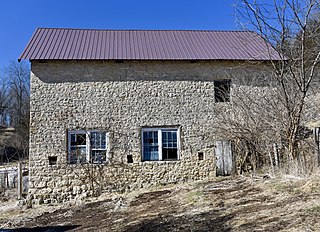
The William Dyas Barn is a historic agricultural building located south of Bellevue, Iowa, United States. It is one of over 217 limestone structures in Jackson County from the mid-19th century, of which 58 are non-residential, agricultural related structures. The stones used to build the barn were quarried, but they vary widely in size and shape. The larger stones are at the bottom of the structure, and they diminish in size the higher up on the walls. An unusual feature on this barn is that the gable ends are not stone, but timber. The Dyas family were among the first settlers in Jackson County, arriving in 1833. They built five houses in this valley. William Dyas built a brick house along with this barn. It is believed there were many more stone barns in the county, but they have been removed over the years. That gives this barn the added significance of being an example of a vanishing building type. It was listed on the National Register of Historic Places in 1991.

The Burlington Traction Company is a historic trolley maintenance facility at Riverside Avenue and North Winooski Avenue in Burlington, Vermont. The property includes two brick trolley barns, built c. 1900 and c. 1910 respectively, that were used as public transit maintenance facilities until 1999, after which they were adaptively repurposed to other residential and commercial uses. The property was listed on the National Register of Historic Places in 2004.
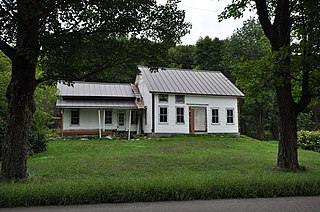
The Preston–Lafreniere Farm is a historic farm property at Duxbury and Honey Hollow Roads in Bolton, Vermont. Established in the early 19th century, it was operated by five generations of the Preston family through the 1990s. The property includes both a house and barn that date to the early 19th century. It was listed on the National Register of Historic Places in 1999, and is subject to a conservation easement held by the state.

The Winterbotham Estate is a historic former estate property at 163 South Willard Street in Burlington, Vermont. Developed beginning about 1820, it is a prominent local example of a Federal period country estate, with many later additions. The property was listed on the National Register of Historic Places in 1975, at which time it housed the city's school administration. It now houses administrative offices of Champlain College, and is called Skiff Hall.

Drake Farm is a historic farmstead at 148 Lafayette Road in North Hampton, New Hampshire. Built in 1890, the main farmhouse is a well-preserved example of a connected New England farmstead. It was listed on the National Register of Historic Places in 2016.

Eagar Townsite Historic District is a section of the town of Eagar, Arizona which has been designated a National Historic Place. Sitting on roughly 54 acres, the site contains 37 structures, 21 of which have historical significance. The period of significance is from 1886, the year the townsite was founded, through 1942, which represents the significant period of development of the town. The site was added to the Register on July 23, 1993.
The Miguel Valdez Barn, on San Joaquin Church Loop Rd. in Encenada, New Mexico, was likely built in the 1920s. It was listed on the National Register of Historic Places in 1986.



















